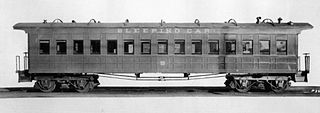
A train is a form of transport consisting of a series of connected vehicles that generally runs along a rail track to transport cargo or passengers. The word "train" comes from the Old French trahiner, derived from the Latin trahere meaning "to pull" or "to draw".

A conductor or guard is a train crew member responsible for operational and safety duties that do not involve actual operation of the train. The conductor title is most common in North American railway operations, but the role is common worldwide under various job titles. In Commonwealth English, a conductor is also known as guard or train manager.

First class is the most luxurious travel class of seats and service on a train, passenger ship, airplane, bus, or other system of transport. It is usually more expensive than business class and economy class, and offers the best service and luxurious accommodation.
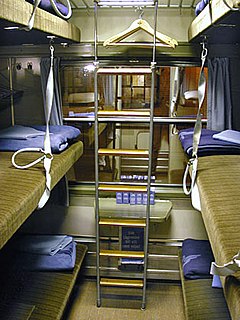
A couchette car is a railway carriage conveying non or semi-private sleeping accommodation.

The bilevel car or double-decker train is a type of rail car that has two levels of passenger accommodation, as opposed to one, increasing passenger capacity. In some countries such vehicles are commonly referred to as dostos, derived from the German Doppelstockwagen.

The Superliner is a type of bilevel intercity railroad passenger car used by Amtrak, the national rail passenger carrier in the United States. Amtrak ordered the cars to replace older single-level cars on its long-distance trains in the Western United States. The design was based on the Budd Hi-Level vehicles, employed by the Santa Fe Railway on its El Capitan trains. Pullman-Standard built 284 cars, known as Superliner I, in 1975–1981; Bombardier Transportation built 195, known as Superliner II, in 1991–1996. The Superliner I cars were the last passenger cars built by Pullman.
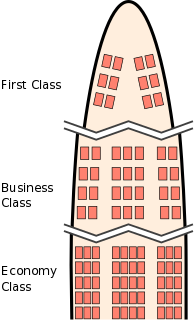
A travel class is a quality of accommodation on public transport. The accommodation could be a seat or a cabin for example. Higher travel classes are designed to be more comfortable and are typically more expensive.
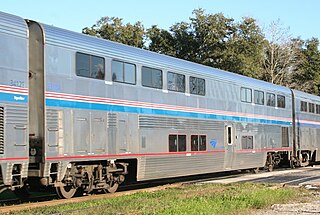
A passenger car is a piece of railway rolling stock that is designed to carry passengers. The term passenger car can also be associated with a sleeping car, baggage, dining, railway post office and prisoner transport cars.

Auto Train is an 855-mile-long (1,376 km) scheduled train service for passengers and their automobiles operated by Amtrak between Lorton, Virginia, and Sanford, Florida. Although there are similar services around the world, the Auto Train is the only one of its kind in the United States. The Auto Train is the only north–south Amtrak train in the east to use Superliner cars.

Auto-Train Corporation was a privately owned railroad which used its own rolling stock, and traveled on rails leased from major railroads along the route of its trains, serving central Florida from points in the Mid-Atlantic region near Washington, DC, and the Midwest near Louisville, Kentucky, during the 1970s. Despite the popularity of the service on its primary route, which parallels busy Interstate 95 along much of the eastern coast of the United States in five states, the company failed financially after operating for almost 10 years. After a hiatus, a similarly named and operated service was begun under the government-financed Amtrak in 1983, which became one of the railroad's most popular services.

The North Coast Limited was a named passenger train operated by the Northern Pacific Railway between Chicago and Seattle via Bismarck, North Dakota. It started on April 29, 1900, and continued as a Burlington Northern Railroad train after the merger on March 2, 1970 with Great Northern Railway and the Chicago, Burlington and Quincy Railroad. The next year, it ceased operations after the trains which left their originating stations on April 30, 1971, the day before Amtrak began service, arrived at their destinations.

The Capitol Limited was an American passenger train run by the Baltimore and Ohio Railroad, originally between New York City and Grand Central Station in Chicago, Illinois, via Union Station, Washington, D.C., and Pittsburgh. For almost 48 years, it was the B&O's flagship passenger train, noted for personalized service and innovation. At the time of its discontinuation on May 1, 1971, when Amtrak took over most rail passenger service in the U.S., the Capitol Limited operated between Washington and Chicago.
The Federal Express was an overnight named passenger train run by the Pennsylvania Railroad and the New York, New Haven and Hartford Railroad between Washington, DC's Union Station and Boston, Massachusetts's South Station from 1912 to 1971. Train numbers on both railroads were 172 northbound and 173 southbound. At different times, its route has taken it across the Hudson River via a car float between Port Morris and Jersey City, the Poughkeepsie Bridge, and finally the Pennsylvania Tunnel and Terminal Railroad. The final routing was identical to today's high-speed Northeast Corridor.
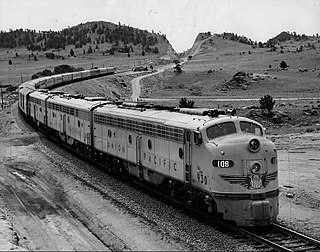
The Challengers were named passenger trains on the Union Pacific Railroad and the Chicago and North Western Railway. The economy service ran between Chicago, Illinois, and the West Coast of the United States. The trains had full Pullman service and coach seating and were an attempt to draw Depression-Era riders back to the rails. Food service was advertised as "three meals for under a dollar a day."
The Sydney/Melbourne Express was an overnight intercapital passenger train service that operated between the Australia's largest two cities, Sydney and Melbourne, between August 1986 and November 1993. Operated jointly by State Rail Authority and V/Line the name depended on the direction of travel, with the train nicknamed the 'Sex' or 'Mex'.

Communications-based train control (CBTC) is a railway signaling system that makes use of the telecommunications between the train and track equipment for the traffic management and infrastructure control. By means of the CBTC systems, the exact position of a train is known more accurately than with the traditional signaling systems. This results in a more efficient and safe way to manage the railway traffic. Metros are able to improve headways while maintaining or even improving safety.

The California Car is the first generation of intercity railcars owned by the California Department of Transportation (Caltrans) and operated by Amtrak under the Amtrak California brand on intercity corridor routes in Northern and Central California. The cars were built in the mid-1990s for the Caltrans Division of Rail by Morrison-Knudsen. The cars are similar to Amtrak's Superliner, but original in design to provide rolling stock suitable for California intercity services up to six hours, with more frequent stops than most other Amtrak routes. All cars were overhauled by Alstom at its Mare Island facility between 2009 and 2012.
The Night Owl was a passenger train operated by Amtrak on the Northeast Corridor between Washington, D.C., and Boston, Massachusetts, via New York City. It operated from 1972 to 1995 on an overnight schedule with sleeper service; it was the only such train on the Northeast Corridor. In 1995 Amtrak dropped most individual train names from its Northeast Corridor services and the Night Owl became another NortheastDirect service, but still on an overnight schedule. Amtrak replaced it with the Twilight Shoreliner in 1997.


